Education Systems of England and China
VerifiedAdded on 2019/12/03
|5
|1437
|260
Essay
AI Summary
This essay provides a detailed comparison of the education systems in England and China. It explores the similarities and differences in their primary, secondary, and higher education structures, funding mechanisms, and quality standards. The essay highlights the scientific and practical approach of England's system versus the traditional approach of China's system. It also discusses the organizational structures, funding sources, and quality assurance measures in both countries. The conclusion summarizes the strengths and weaknesses of each system, suggesting areas for improvement.
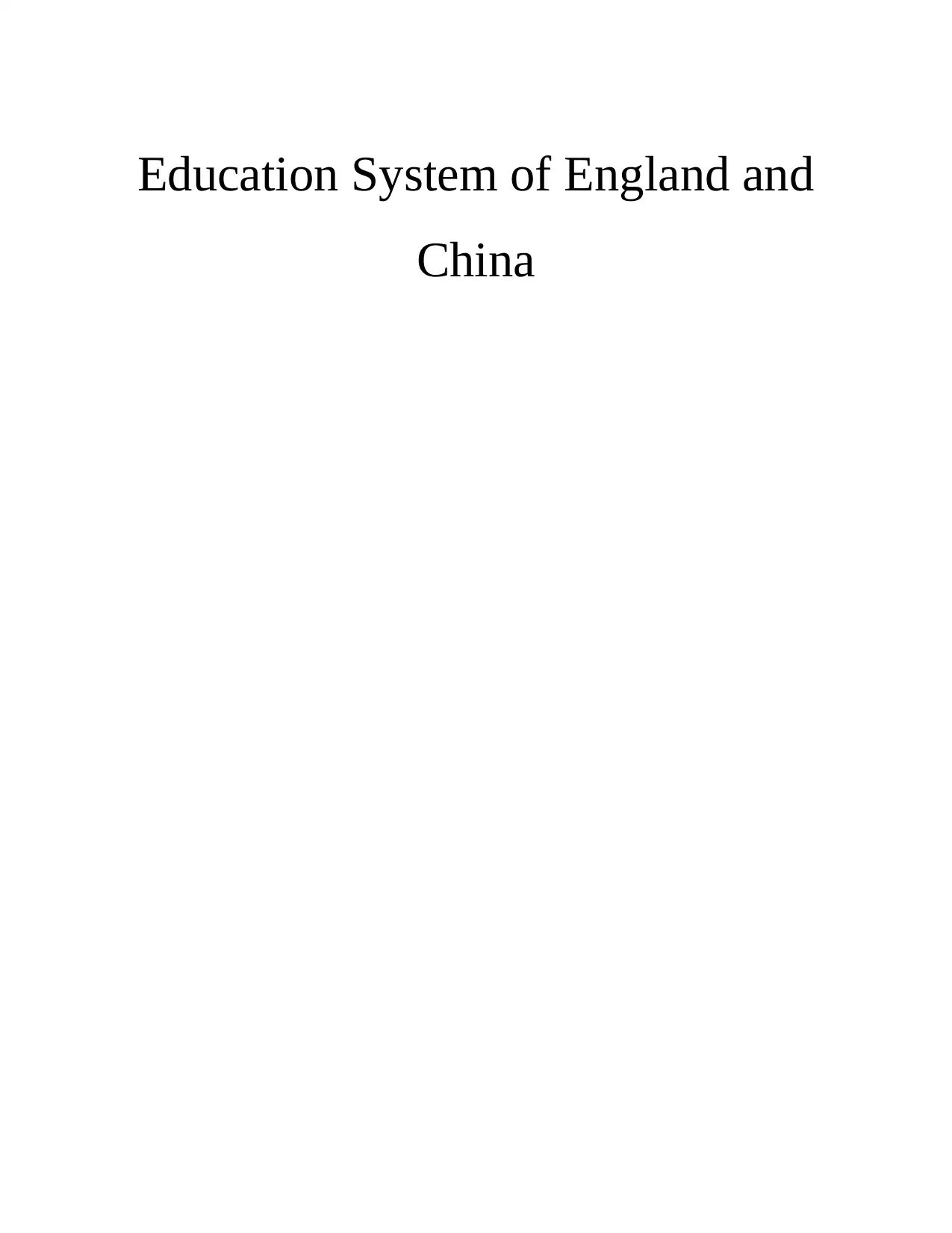
Education System of England and
China
China
Paraphrase This Document
Need a fresh take? Get an instant paraphrase of this document with our AI Paraphraser
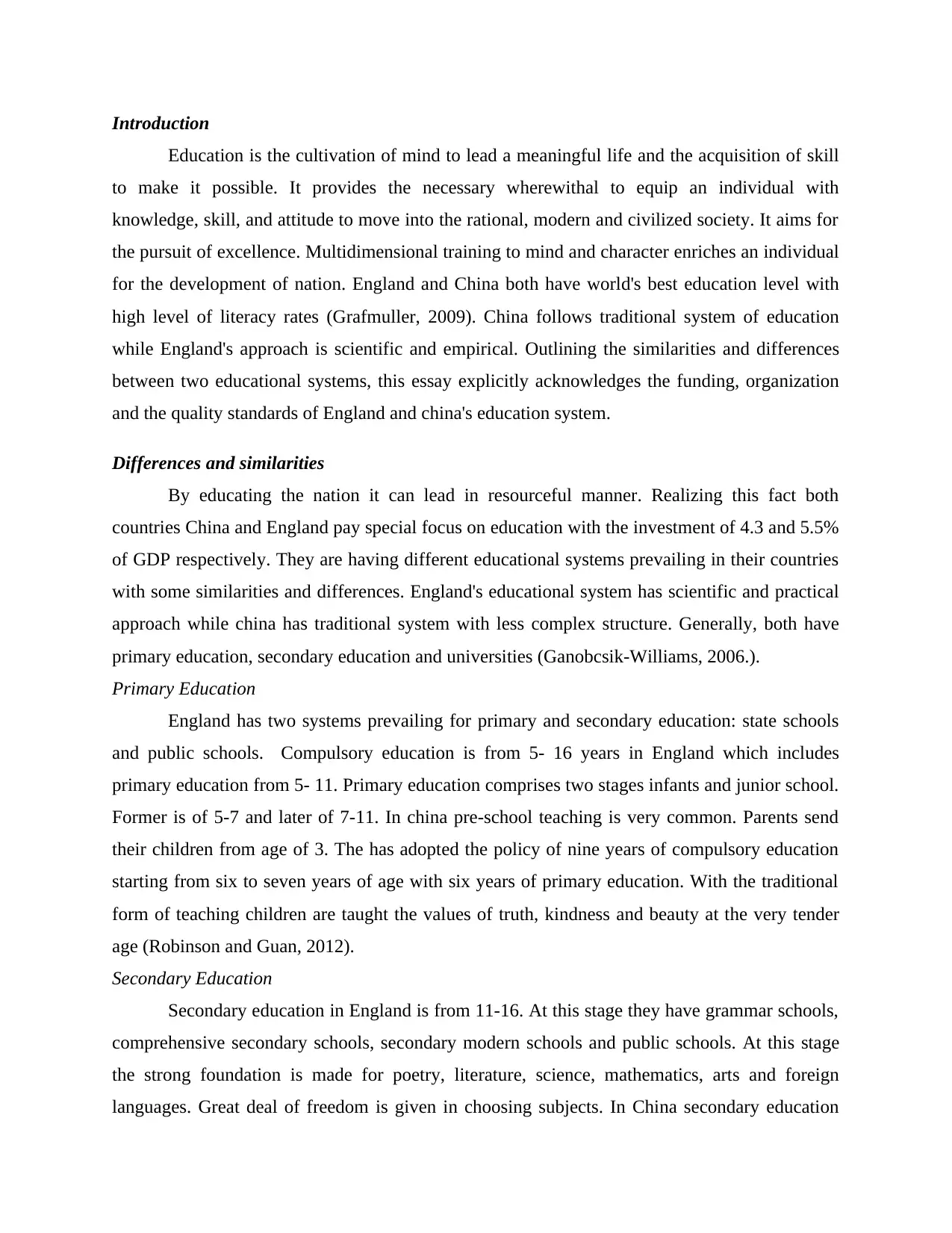
Introduction
Education is the cultivation of mind to lead a meaningful life and the acquisition of skill
to make it possible. It provides the necessary wherewithal to equip an individual with
knowledge, skill, and attitude to move into the rational, modern and civilized society. It aims for
the pursuit of excellence. Multidimensional training to mind and character enriches an individual
for the development of nation. England and China both have world's best education level with
high level of literacy rates (Grafmuller, 2009). China follows traditional system of education
while England's approach is scientific and empirical. Outlining the similarities and differences
between two educational systems, this essay explicitly acknowledges the funding, organization
and the quality standards of England and china's education system.
Differences and similarities
By educating the nation it can lead in resourceful manner. Realizing this fact both
countries China and England pay special focus on education with the investment of 4.3 and 5.5%
of GDP respectively. They are having different educational systems prevailing in their countries
with some similarities and differences. England's educational system has scientific and practical
approach while china has traditional system with less complex structure. Generally, both have
primary education, secondary education and universities (Ganobcsik-Williams, 2006.).
Primary Education
England has two systems prevailing for primary and secondary education: state schools
and public schools. Compulsory education is from 5- 16 years in England which includes
primary education from 5- 11. Primary education comprises two stages infants and junior school.
Former is of 5-7 and later of 7-11. In china pre-school teaching is very common. Parents send
their children from age of 3. The has adopted the policy of nine years of compulsory education
starting from six to seven years of age with six years of primary education. With the traditional
form of teaching children are taught the values of truth, kindness and beauty at the very tender
age (Robinson and Guan, 2012).
Secondary Education
Secondary education in England is from 11-16. At this stage they have grammar schools,
comprehensive secondary schools, secondary modern schools and public schools. At this stage
the strong foundation is made for poetry, literature, science, mathematics, arts and foreign
languages. Great deal of freedom is given in choosing subjects. In China secondary education
Education is the cultivation of mind to lead a meaningful life and the acquisition of skill
to make it possible. It provides the necessary wherewithal to equip an individual with
knowledge, skill, and attitude to move into the rational, modern and civilized society. It aims for
the pursuit of excellence. Multidimensional training to mind and character enriches an individual
for the development of nation. England and China both have world's best education level with
high level of literacy rates (Grafmuller, 2009). China follows traditional system of education
while England's approach is scientific and empirical. Outlining the similarities and differences
between two educational systems, this essay explicitly acknowledges the funding, organization
and the quality standards of England and china's education system.
Differences and similarities
By educating the nation it can lead in resourceful manner. Realizing this fact both
countries China and England pay special focus on education with the investment of 4.3 and 5.5%
of GDP respectively. They are having different educational systems prevailing in their countries
with some similarities and differences. England's educational system has scientific and practical
approach while china has traditional system with less complex structure. Generally, both have
primary education, secondary education and universities (Ganobcsik-Williams, 2006.).
Primary Education
England has two systems prevailing for primary and secondary education: state schools
and public schools. Compulsory education is from 5- 16 years in England which includes
primary education from 5- 11. Primary education comprises two stages infants and junior school.
Former is of 5-7 and later of 7-11. In china pre-school teaching is very common. Parents send
their children from age of 3. The has adopted the policy of nine years of compulsory education
starting from six to seven years of age with six years of primary education. With the traditional
form of teaching children are taught the values of truth, kindness and beauty at the very tender
age (Robinson and Guan, 2012).
Secondary Education
Secondary education in England is from 11-16. At this stage they have grammar schools,
comprehensive secondary schools, secondary modern schools and public schools. At this stage
the strong foundation is made for poetry, literature, science, mathematics, arts and foreign
languages. Great deal of freedom is given in choosing subjects. In China secondary education
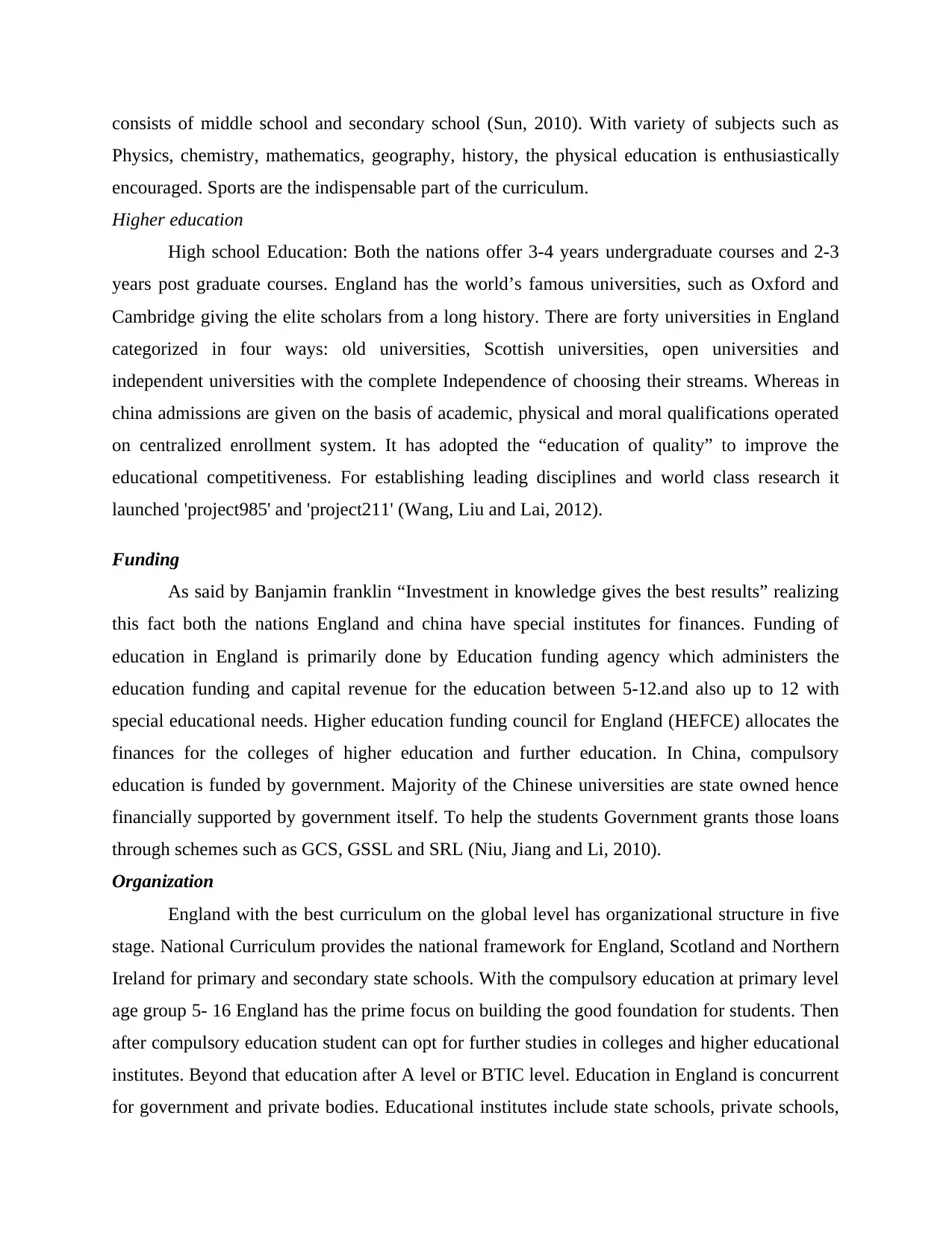
consists of middle school and secondary school (Sun, 2010). With variety of subjects such as
Physics, chemistry, mathematics, geography, history, the physical education is enthusiastically
encouraged. Sports are the indispensable part of the curriculum.
Higher education
High school Education: Both the nations offer 3-4 years undergraduate courses and 2-3
years post graduate courses. England has the world’s famous universities, such as Oxford and
Cambridge giving the elite scholars from a long history. There are forty universities in England
categorized in four ways: old universities, Scottish universities, open universities and
independent universities with the complete Independence of choosing their streams. Whereas in
china admissions are given on the basis of academic, physical and moral qualifications operated
on centralized enrollment system. It has adopted the “education of quality” to improve the
educational competitiveness. For establishing leading disciplines and world class research it
launched 'project985' and 'project211' (Wang, Liu and Lai, 2012).
Funding
As said by Banjamin franklin “Investment in knowledge gives the best results” realizing
this fact both the nations England and china have special institutes for finances. Funding of
education in England is primarily done by Education funding agency which administers the
education funding and capital revenue for the education between 5-12.and also up to 12 with
special educational needs. Higher education funding council for England (HEFCE) allocates the
finances for the colleges of higher education and further education. In China, compulsory
education is funded by government. Majority of the Chinese universities are state owned hence
financially supported by government itself. To help the students Government grants those loans
through schemes such as GCS, GSSL and SRL (Niu, Jiang and Li, 2010).
Organization
England with the best curriculum on the global level has organizational structure in five
stage. National Curriculum provides the national framework for England, Scotland and Northern
Ireland for primary and secondary state schools. With the compulsory education at primary level
age group 5- 16 England has the prime focus on building the good foundation for students. Then
after compulsory education student can opt for further studies in colleges and higher educational
institutes. Beyond that education after A level or BTIC level. Education in England is concurrent
for government and private bodies. Educational institutes include state schools, private schools,
Physics, chemistry, mathematics, geography, history, the physical education is enthusiastically
encouraged. Sports are the indispensable part of the curriculum.
Higher education
High school Education: Both the nations offer 3-4 years undergraduate courses and 2-3
years post graduate courses. England has the world’s famous universities, such as Oxford and
Cambridge giving the elite scholars from a long history. There are forty universities in England
categorized in four ways: old universities, Scottish universities, open universities and
independent universities with the complete Independence of choosing their streams. Whereas in
china admissions are given on the basis of academic, physical and moral qualifications operated
on centralized enrollment system. It has adopted the “education of quality” to improve the
educational competitiveness. For establishing leading disciplines and world class research it
launched 'project985' and 'project211' (Wang, Liu and Lai, 2012).
Funding
As said by Banjamin franklin “Investment in knowledge gives the best results” realizing
this fact both the nations England and china have special institutes for finances. Funding of
education in England is primarily done by Education funding agency which administers the
education funding and capital revenue for the education between 5-12.and also up to 12 with
special educational needs. Higher education funding council for England (HEFCE) allocates the
finances for the colleges of higher education and further education. In China, compulsory
education is funded by government. Majority of the Chinese universities are state owned hence
financially supported by government itself. To help the students Government grants those loans
through schemes such as GCS, GSSL and SRL (Niu, Jiang and Li, 2010).
Organization
England with the best curriculum on the global level has organizational structure in five
stage. National Curriculum provides the national framework for England, Scotland and Northern
Ireland for primary and secondary state schools. With the compulsory education at primary level
age group 5- 16 England has the prime focus on building the good foundation for students. Then
after compulsory education student can opt for further studies in colleges and higher educational
institutes. Beyond that education after A level or BTIC level. Education in England is concurrent
for government and private bodies. Educational institutes include state schools, private schools,
⊘ This is a preview!⊘
Do you want full access?
Subscribe today to unlock all pages.

Trusted by 1+ million students worldwide
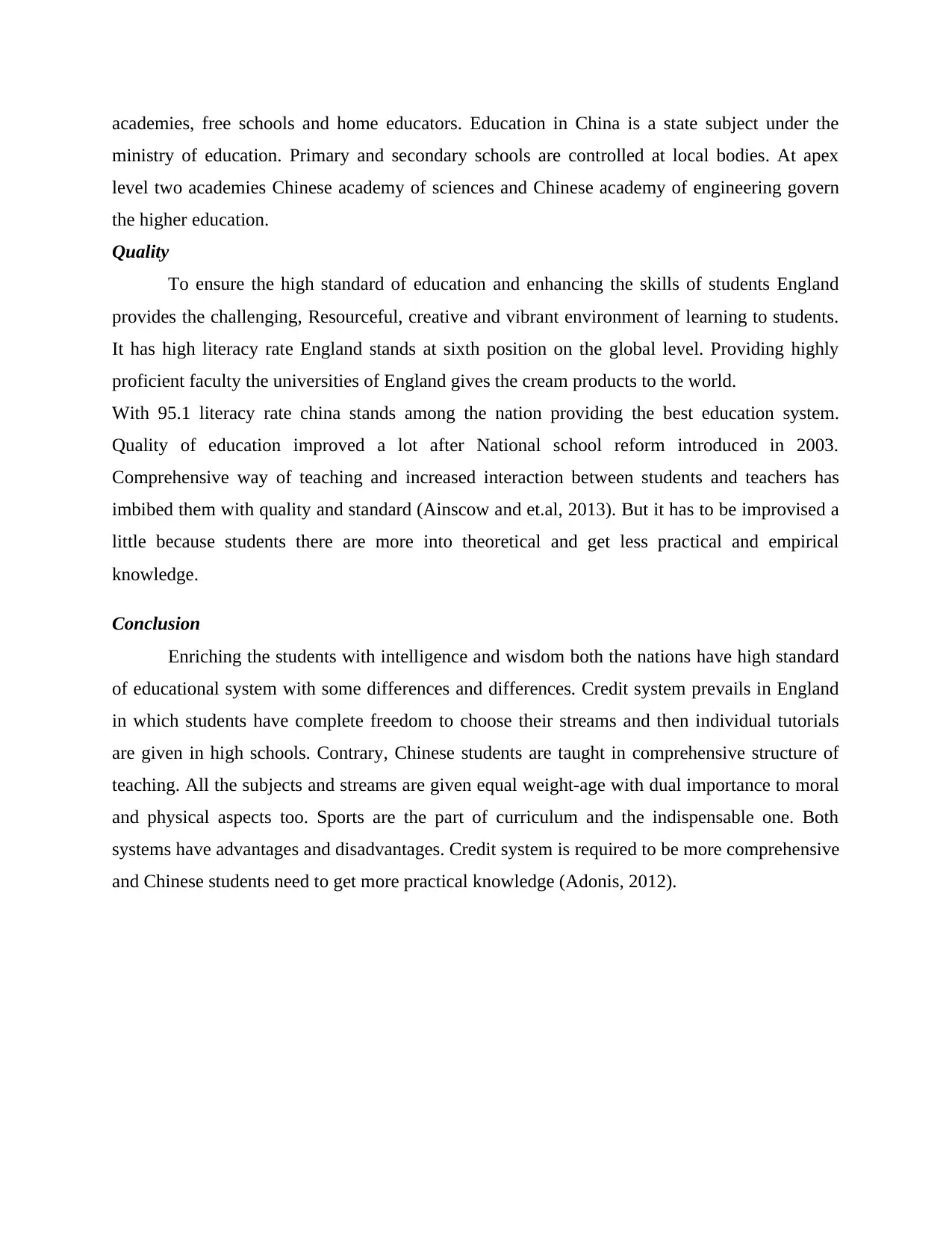
academies, free schools and home educators. Education in China is a state subject under the
ministry of education. Primary and secondary schools are controlled at local bodies. At apex
level two academies Chinese academy of sciences and Chinese academy of engineering govern
the higher education.
Quality
To ensure the high standard of education and enhancing the skills of students England
provides the challenging, Resourceful, creative and vibrant environment of learning to students.
It has high literacy rate England stands at sixth position on the global level. Providing highly
proficient faculty the universities of England gives the cream products to the world.
With 95.1 literacy rate china stands among the nation providing the best education system.
Quality of education improved a lot after National school reform introduced in 2003.
Comprehensive way of teaching and increased interaction between students and teachers has
imbibed them with quality and standard (Ainscow and et.al, 2013). But it has to be improvised a
little because students there are more into theoretical and get less practical and empirical
knowledge.
Conclusion
Enriching the students with intelligence and wisdom both the nations have high standard
of educational system with some differences and differences. Credit system prevails in England
in which students have complete freedom to choose their streams and then individual tutorials
are given in high schools. Contrary, Chinese students are taught in comprehensive structure of
teaching. All the subjects and streams are given equal weight-age with dual importance to moral
and physical aspects too. Sports are the part of curriculum and the indispensable one. Both
systems have advantages and disadvantages. Credit system is required to be more comprehensive
and Chinese students need to get more practical knowledge (Adonis, 2012).
ministry of education. Primary and secondary schools are controlled at local bodies. At apex
level two academies Chinese academy of sciences and Chinese academy of engineering govern
the higher education.
Quality
To ensure the high standard of education and enhancing the skills of students England
provides the challenging, Resourceful, creative and vibrant environment of learning to students.
It has high literacy rate England stands at sixth position on the global level. Providing highly
proficient faculty the universities of England gives the cream products to the world.
With 95.1 literacy rate china stands among the nation providing the best education system.
Quality of education improved a lot after National school reform introduced in 2003.
Comprehensive way of teaching and increased interaction between students and teachers has
imbibed them with quality and standard (Ainscow and et.al, 2013). But it has to be improvised a
little because students there are more into theoretical and get less practical and empirical
knowledge.
Conclusion
Enriching the students with intelligence and wisdom both the nations have high standard
of educational system with some differences and differences. Credit system prevails in England
in which students have complete freedom to choose their streams and then individual tutorials
are given in high schools. Contrary, Chinese students are taught in comprehensive structure of
teaching. All the subjects and streams are given equal weight-age with dual importance to moral
and physical aspects too. Sports are the part of curriculum and the indispensable one. Both
systems have advantages and disadvantages. Credit system is required to be more comprehensive
and Chinese students need to get more practical knowledge (Adonis, 2012).
Paraphrase This Document
Need a fresh take? Get an instant paraphrase of this document with our AI Paraphraser
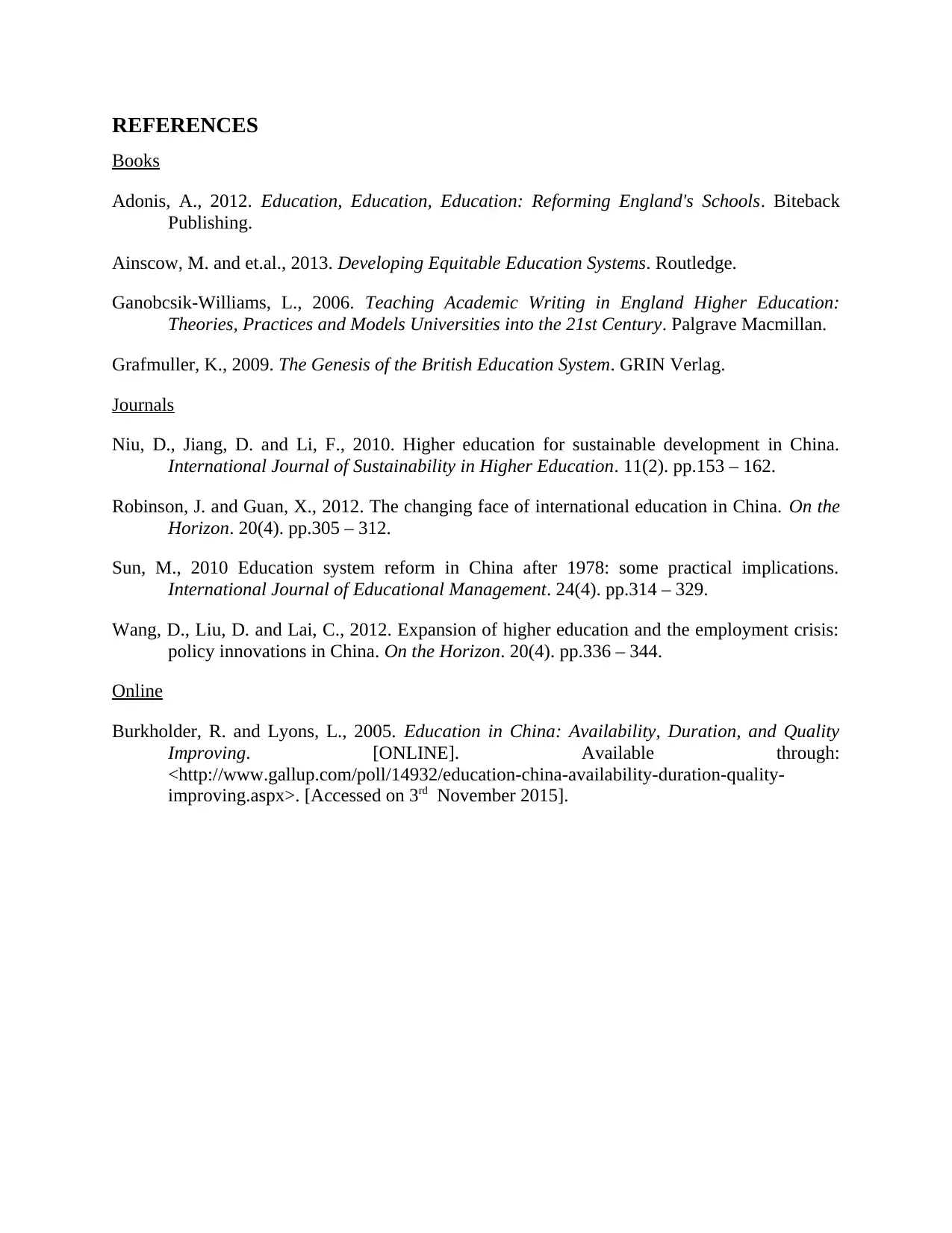
REFERENCES
Books
Adonis, A., 2012. Education, Education, Education: Reforming England's Schools. Biteback
Publishing.
Ainscow, M. and et.al., 2013. Developing Equitable Education Systems. Routledge.
Ganobcsik-Williams, L., 2006. Teaching Academic Writing in England Higher Education:
Theories, Practices and Models Universities into the 21st Century. Palgrave Macmillan.
Grafmuller, K., 2009. The Genesis of the British Education System. GRIN Verlag.
Journals
Niu, D., Jiang, D. and Li, F., 2010. Higher education for sustainable development in China.
International Journal of Sustainability in Higher Education. 11(2). pp.153 – 162.
Robinson, J. and Guan, X., 2012. The changing face of international education in China. On the
Horizon. 20(4). pp.305 – 312.
Sun, M., 2010 Education system reform in China after 1978: some practical implications.
International Journal of Educational Management. 24(4). pp.314 – 329.
Wang, D., Liu, D. and Lai, C., 2012. Expansion of higher education and the employment crisis:
policy innovations in China. On the Horizon. 20(4). pp.336 – 344.
Online
Burkholder, R. and Lyons, L., 2005. Education in China: Availability, Duration, and Quality
Improving. [ONLINE]. Available through:
<http://www.gallup.com/poll/14932/education-china-availability-duration-quality-
improving.aspx>. [Accessed on 3rd November 2015].
Books
Adonis, A., 2012. Education, Education, Education: Reforming England's Schools. Biteback
Publishing.
Ainscow, M. and et.al., 2013. Developing Equitable Education Systems. Routledge.
Ganobcsik-Williams, L., 2006. Teaching Academic Writing in England Higher Education:
Theories, Practices and Models Universities into the 21st Century. Palgrave Macmillan.
Grafmuller, K., 2009. The Genesis of the British Education System. GRIN Verlag.
Journals
Niu, D., Jiang, D. and Li, F., 2010. Higher education for sustainable development in China.
International Journal of Sustainability in Higher Education. 11(2). pp.153 – 162.
Robinson, J. and Guan, X., 2012. The changing face of international education in China. On the
Horizon. 20(4). pp.305 – 312.
Sun, M., 2010 Education system reform in China after 1978: some practical implications.
International Journal of Educational Management. 24(4). pp.314 – 329.
Wang, D., Liu, D. and Lai, C., 2012. Expansion of higher education and the employment crisis:
policy innovations in China. On the Horizon. 20(4). pp.336 – 344.
Online
Burkholder, R. and Lyons, L., 2005. Education in China: Availability, Duration, and Quality
Improving. [ONLINE]. Available through:
<http://www.gallup.com/poll/14932/education-china-availability-duration-quality-
improving.aspx>. [Accessed on 3rd November 2015].
1 out of 5
Related Documents
Your All-in-One AI-Powered Toolkit for Academic Success.
+13062052269
info@desklib.com
Available 24*7 on WhatsApp / Email
![[object Object]](/_next/static/media/star-bottom.7253800d.svg)
Unlock your academic potential
Copyright © 2020–2025 A2Z Services. All Rights Reserved. Developed and managed by ZUCOL.





